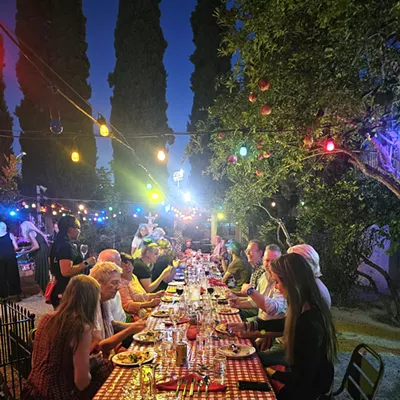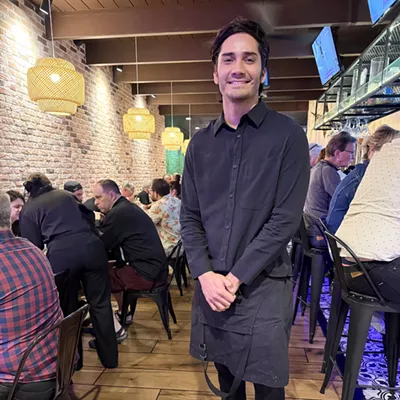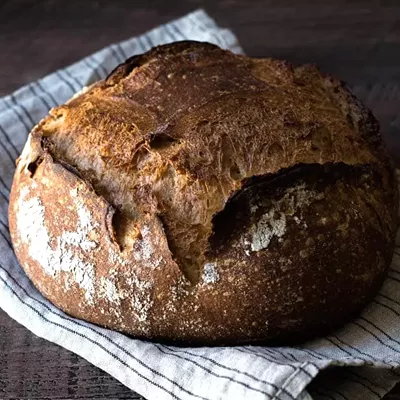Tucson is turning into a more metropolitan city every day, with posh new restaurants opening throughout downtown, and a growing diversity in the type of cuisine available. Now comes Café Desta, a welcome spot in the Barrio Viejo/Armory Park area—which suffers from a dearth of restaurants of any type.
Just the second Ethiopian restaurant to grace the streets of the Old Pueblo today, Café Desta is small but spacious-feeling and modern, and the oversized black-and-white photography on the walls is beautifully striking. Gracing one of the corners of the "five points" intersection just south of downtown, parking at Café Desta is quite the challenge, however.
Our first visit was Ted's inaugural foray into Ethiopian food—and Café Desta left an excellent first impression. The café was bustling, but our server (also one of the restaurant's owners) was extremely quick and friendly, bringing out water and guava juice ($2) right away.
The menu is simple, and the portions are generous. For dinner, we decided on the two-person combination platter ($24.95), which is a combination of any five items from the front side of the menu, which includes an array of vegetarian, fish, chicken and lamb selections, served with salad and injera, the trademark spongy bread of Ethiopia.
We picked out kik, yellow split peas with onion, turmeric and herbs; fosolia, green beans stewed with carrots and onions in a tomato sauce; alicha doro, chicken with turmeric, onions and spices; kaye beg, lamb cooked with berbere, onions and spices; and kaye asa, white fish cooked in the same style as the lamb. We also opted for a side of ayeb, a fresh, mild, white cheese made from buttermilk and whole milk, on the recommendation of our server.
Our food came out on a family-style platter covered in a layer of injera, with generous piles of each dish and two individual heaps of salad, as well as two separate baskets full of injera. Ethiopian food is traditionally eaten with the hands, and Café Desta sticks to this tradition: Nothing is served with utensils unless you request them.
The injera was thin, fresh, tangy and just slightly chewy, but sturdy enough to hold up while scooping the saucy meat dishes. The green-bean dish was my favorite of the entrées, slowly cooked and soft without being mushy or stringy. The lamb and fish, both cooked in berbere (a spice mixture with chile, garlic and ginger, among other components), were spicy but not too spicy, and when mixed with the tangy cheese, it all mellowed out wonderfully.
We tried to stop by for lunch over the weekend, but Café Desta's summer hours are in effect, which means the restaurant is closed on Sunday and open only for dinner on Saturday.
A few days later, our lunch visit was quite successful—but not quite as lightning-fast as our dinner experience.
This time, we decided to try out the specialty dishes on the menu. Ted ordered the kitfo ($15.75), which is a finely minced beef—with a ground-beef-like texture—mixed with cardamom and traditional Ethiopian spices, and served rare with a salad, injera and gomen, a mixture of chopped collard greens with garlic and onions. I chose the beef tibs ($13.75, $15.75 for lamb), pan-seared beef cubes with onions, jalapeños and rosemary, served with salad, injera and green beans.
Again, our entrées came out family-style on a huge platter, and each entrée was easily enough for two people to share. (You can request that the entrées come on individual plates if you're squeamish about sharing.) The tibs were fragrant and tender, but I wished that the jalapeños had added a touch more heat. You can request "awaze tibs" if you're truly in it for the spiciness. The kitfo was one of the most complex meat dishes I've ever had—the cardamom and beef isn't a flavor combination I'm accustomed to, and it hinted at being sweet without actually tasting sweet. I wasn't a fan of the beef's texture, but it didn't bother Ted at all.
Café Desta offered a delightful dining experience, and there is something about sharing food from the same plate that really makes the occurrence special. It is a welcome addition to the growing downtown restaurant world, and a departure from the typical Tucson lineup of ethnic foods.







